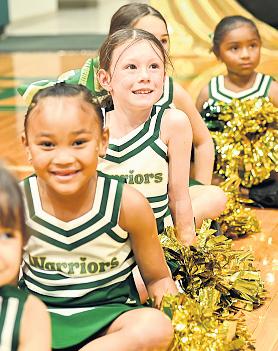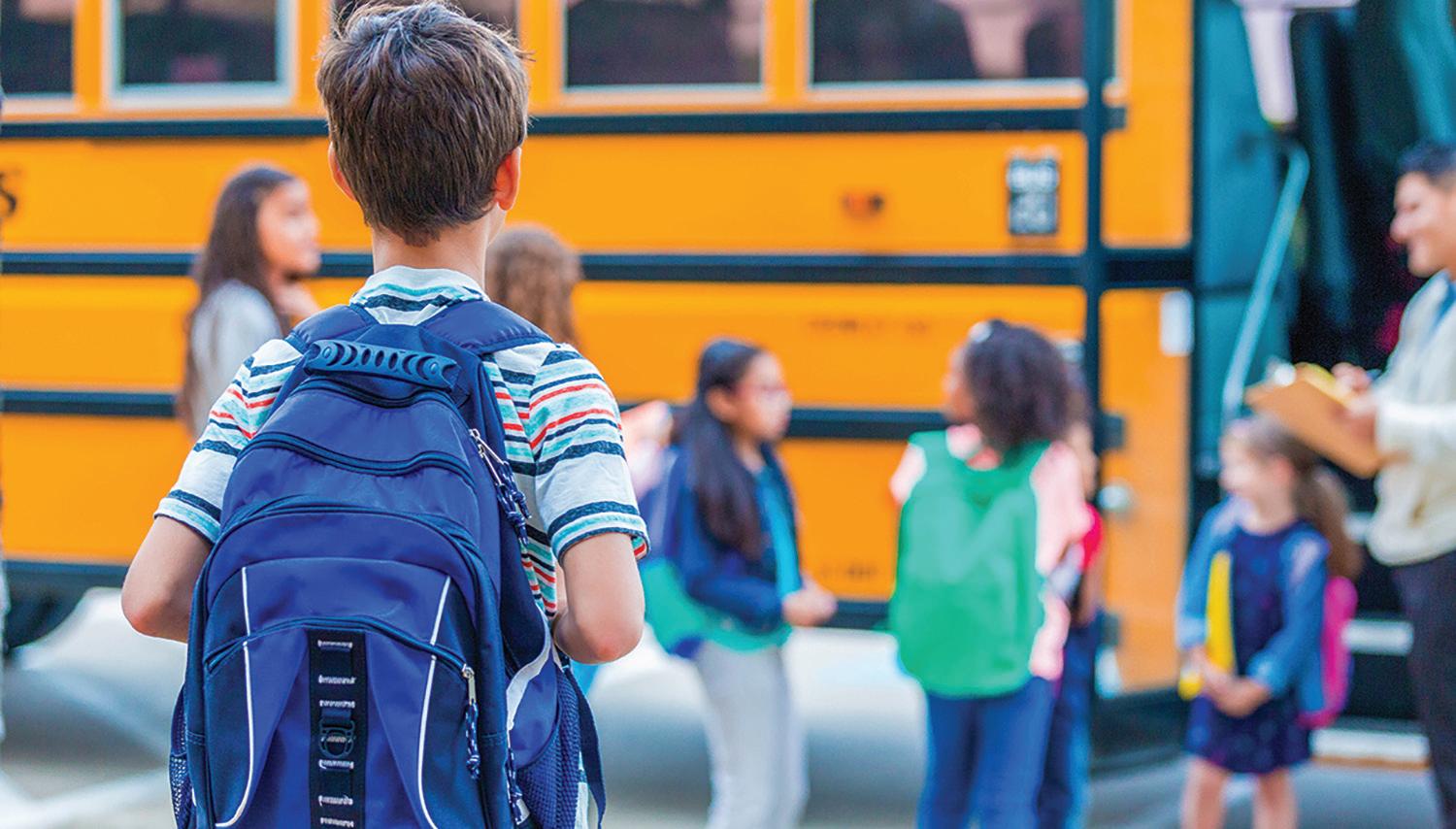








Whether your child walks, rides a bike, takes the bus or drives themselves to school, getting there safely is always the top priority. Each method of transportation comes with its own set of challenges, especially as routines change, traffic increases and daylight shifts with the seasons.
By taking time to review safety basics and encourage smart habits, families can start the school year with confidence and peace of mind.
If your child walks to school, make sure they know the safest route and stick to it. Sidewalks, crosswalks and crossing guards should always be part of the plan. Practice the route together a few times before the first day, pointing out intersections and reminding them to look both ways before crossing.
For bikers, helmets are a must, no exceptions. Check the bike is the right size and in good condition, with working brakes and reflectors. Encourage kids to ride in single file and follow all traffic signs. Bright or reflective clothing can help them stay visible, especially on cloudy mornings or shorter fall days.
Avoid distractions like phones or headphones, which can take eyes and ears off the road. Teach kids to stay aware of their surroundings and to walk or bike with friends whenever possible.
The school bus is one of the safest ways for students to travel, but it’s important to follow the rules both on and off the bus. Remind kids to stand back from the curb while waiting and to only approach the bus when it comes to a complete stop. If they need to cross the street in front of the bus, they should make eye

contact with the driver and wait for a signal before stepping out.
Onboard, kids should stay seated, keep aisles clear and speak quietly so the driver can concentrate. Backpacks should be zipped and kept out of the walkway to avoid tripping.
For younger riders, consider a backpack tag with emergency contact
information and review bus stop behavior with them frequently.
For families with new drivers, the start of the school year is a great time to reinforce safe driving habits. Teens should always buckle up, obey speed limits and eliminate distractions, especially phones.
Make sure your teen
knows the school’s traffic flow, drop-off zones and parking rules. Encourage them to leave early enough to avoid rushing and to check the weather before leaving each morning. Parents can also set clear expectations through a driving agreement that covers curfews, passenger limits and consequences for unsafe behavior.
Talking regularly about safety — and modeling it as adults — goes a long way in helping kids develop good habits that last. A few simple reminders can make a big difference in helping students of all ages arrive safely and start their day with confidence.

LCA is a Christ-centered college preparatory school dedicated to preparing students for college and life. We nur ture young men and women spiritually, academically, physically, and creatively to help them achieve their God-given potential

Bible classes, weekly chapel services, and a scripture memorization challenge. Two ministry days per year dedicated to serving the community and a yearly service hour requirement
Academic Excellence
Elementary STEM focus and AR. Secondary Advanced Placement and dual-credit courses
Average SAT scores c/o 2026 taken in 11 grade: English/Reading: 624 and Math: 562
Over 90% of students participate in one of many opportunities including a spring theatre production, drumline, horticulture, student council, mock trial, and various student-led clubs.
Athletics
Baseball, Basketball, Cheer, Cross-country, Fishing, Football, Golf, Soccer, Tennis, Track, and Volleyball.
90% of LCA varsity teams competed in the 2024-25 TAPPS state playoffs.






Bullying can happen to just about anyone in any school in any town in the country.


It is important to realize that bullying can occur in person, online and even through devices. Rumor-spreading and verbal insults are forms of bullying. Students do not always report behaviors that are indicative of bullying, so bullying instances may be greater than data suggests. The Monique Burr Foundation for Children says 13 million students will be bullied in the United States this year. Around 160,000 students miss school daily for fear of being bullied. The U.S. Department of Justice says one in four children are bullied. Bullying also is a problem in Canada. According to the 2019 Canadian Health Survey on Children and Youth, the majority of Canadian youth between the ages of 12 and 17 (71 percent) reported experiencing at least one form of bullying in the 12-month period prior to the survey. Eighty-nine percent of Canadian teachers see cyberbullying as a top concern, and 42 percent of bullied youths face it monthly. Parents, educators and students need to be aware of bullying and treat it with the concern it deserves.
A new school year presents a wealth of opportunities for students.
At the dawn of a new school year, students have a chance to further their academic careers, student-athletes may be given a shot at making a team or moving up to varsity, and extracurriculars provide a chance for personal growth outside the classroom.
Despite all that a new school year represents, students may need a little extra motivation to get excited about going back to campus once summer winds down. A relaxing and largely obligation-free summer vacation can be tough to give up, as can mornings without alarm clocks. Parents recognize that kids might not be enthusiastic about the return of early mornings and sessions in the classroom. In such instances, parents can try the following strategies to get kids excited about a
new school year.
• Make the first day special.
First days can be challenging regardless of a person’s age. Professionals with years of experience in their field still feel first-day jitters when they begin a new job, so youngsters can be excused if what seems like a lack of excitement is really just nervousness about a new school year. Parents can calm those nerves by doing something to make the first day special. Skip the standard cereal and prepare a homecooked breakfast or let kids buy lunch at the school cafeteria instead of packing a PB&J in their lunchbox. A little something special on the first day can go a long way toward getting kids excited about going back to school.
• Emphasize new subjects.
As children advance through school, they’re typically exposed to more engaging subjects or challenged in ways

that helps them build on previous years’ work. Emphasizing new subjects or opportunities can increase kids’ excitement to get back in the school year swing of things. If a youngster likes playing an instrument, emphasize how the new school year is an opportunity to get better, play alongside other students and take a talent to new heights. If students are old enough to take sub-
jects they’ve long been interested in, such as a foreign language, make a point to emphasize how that opportunity has finally arrived.
• Create a school calendar. Schools typically make their yearly schedules available prior to the first day of school. Parents can peruse those schedules alongside their children and make a calendar noting special days. Mark down field trips,
special events involving parents and students, school performances where kids get to act or sing on stage, and other notable moments during the school year. Kids are bound to grow more excited about a new year when they see a year’s worth of fun events marked down on a calendar.
• Host a late summer get-together with friends. A late-summer pool party or play date with
various friends can remind youngsters that they’re about to see their friends every day. That might be enough to make young students jump out of bed on the first day of school. Students might be less than excited about the end of summer vacation and the dawn of a new school year. But there’s much parents can do to get kids excited about going back to school











ONLINE REGISTRATION NOW OPEN
Beaumont ISD makes it easy for families to register students online for the 2025–26 school year. This quick and convenient process allows parents to verify and update student information from home using a phone, tablet, or computer.








All new and returning students must complete the online registration or renewal each year Students who are not registered will not receive a schedule on the first day of school
Secure your child’s spot and help ensure a smooth start Complete your online registration today!



For help, contact your child’s campus directly Additional support is available through the Office of Student Services at 409-617-5109

The Physical Rehabilitation Network (PRN) says active kids are more likely to become healthy adults. Studies have shown that being physically active and making smart food choices while young can lead to a reduced risk of developing many serious health conditions later in life, which can include diabetes, high blood pressure, obesity, heart disease, and even certain cancers. What’s more, Better Health Victoria in Australia says evidence suggests that physically active children also are more likely to mature into physically active adults. Developing fitness skills early in life is a wise choice. However, one in six kids between the ages of 2 and 19 in the United States are obese, and just one in three are physically active each day, reports the PRN. Families can work together to help kids get on paths to better health and to become more active. This may involve putting limits on screen time and encouraging outdoor play and group active activities like sports or dance

When your child is stuck on a math problem, flustered by a writing assignment or overwhelmed by a science project, it’s tempting to step in and take the reins. But while helping with homework can strengthen learning, doing too much of it can send the wrong message and prevent kids from developing the skills they need to succeed on their own.
So how do parents strike the right balance? With a little strategy and a lot of pa-
tience, you can support your child’s academic growth while still encouraging independence and resilience.
Start by setting up a consistent homework routine and a dedicated workspace free from distractions. A well-lit table with basic supplies nearby helps kids stay focused and organized. Establishing a regular time for homework, whether right after school or after a short break, creates helpful structure. Stay nearby dur-
ing homework time, especially for younger children, but try not to hover. Let them know you’re available if they need help, and check in occasionally to offer encouragement or answer questions.
When your child is stuck, try guiding them to find the solution rather than jumping in with it. Ask prompting questions like, “What do you think the next step is?” or “Can you show me how you got that answer?” Encouraging them to explain their thinking out loud
can help clarify their own understanding. For writing assignments, you might brainstorm ideas together or talk through the structure of a paragraph, but let them choose the words and write the sentences. For math, you can review a similar example problem without solving the one they’re working on.
If your child makes a mistake, resist the urge to fix it. Teachers need to see what a student understands and where they’re struggling to provide meaningful feedback.
Focusing on the learning process — not just the end result — can build confidence and motivation. Praise your child for sticking with a tough assignment, thinking critically or using a new strategy. Let them know it’s OK to make mistakes and that challenges are part of learning.
If homework time becomes a daily struggle or your child seems consistently overwhelmed, reach out to their teacher. They can offer insight into
how much support is expected at home and may suggest modifications or additional resources.
Helping with homework doesn’t mean having all the answers. It means being a cheerleader, a sounding board and a safe place to land when school feels hard. With the right mix of support and independence, your child can build the skills to tackle assignments with growing confidence and take pride in what they accomplish on their own.

As the school year kicks off, students of all ages need a place to focus, think and learn.
A well-designed study space at home can make homework time smoother and help build healthy academic habits that last a lifetime.
Whether you have a kindergartner learning sight words or a high schooler tackling AP exams, creating a space that matches their needs can boost motivation and reduce stress. The key is finding a setup that minimizes distractions, encourages good posture and supports their unique learning style.
Every study space needs a few essentials: a clean, flat surface; comfortable seating; good lighting; and easy access to supplies. That could be a desk in the bedroom, a kitchen table with a homework caddy or a quiet nook in the family room.
If possible, avoid having kids do homework in bed or on the couch, which can lead to poor focus or posture. Even a small table can work well if it’s organized and used consistently.
Good lighting is important, especially for evening study sessions. A desk lamp with adjustable brightness can help reduce eye strain. For younger children, make sure the chair and table height allow their feet to rest flat and their arms to work comfortably.
A productive study area looks different for each age group. Younger children may need more supervision and benefit from working in a shared space where a parent can help as needed. Keep supplies like crayons, scissors and glue sticks nearby in labeled bins or a rolling cart. Use visual aids like checklists or a timer to help them stay on task.
Older students may

need more privacy and fewer interruptions. Encourage middle- and high-schoolers to take ownership of their space by decorating it with motivational quotes, calendars or their own artwork. Provide storage for textbooks, notebooks and devices so everything they need is within reach.
For students learning
online or doing hybrid coursework, a dedicated tech setup can make a big difference. Headphones, a charging station and a place to store a laptop safely can help avoid the scramble before each assignment or virtual meeting.
The best study
space won’t help if it’s surrounded by distractions. Try to keep toys, televisions and noisy siblings away from homework zones. If noise is unavoidable, consider playing soft background music or using white noise to help your child concentrate.
Encourage kids to use their study space at consistent times. Even
just 20–30 minutes a day in the same spot can create a positive routine that supports focus and time management.
No matter how big or small the area, the goal is the same: to help your child feel ready to learn. With just a few thoughtful touches, your home can become a supportive learning environment.





Central Stagg 3455 Stagg Drive Beaumont, TX 77701


Whether it’s a child’s very first day or just a new year with new challenges, books can be powerful tools for easing back-to-school jitters and sparking excitement.
Here are some age-appropriate picks that offer comfort, encouragement and a touch of fun.
PRESCHOOL/ KINDERGARTEN
The Kissing Hand by Audrey Penn. A gentle story about separation anxiety, this sweet tale of a raccoon heading to school re-
assures young children that a parent’s love stays with them wherever they go.
Maisy Goes to Preschool by Lucy Cousins. Colorful and upbeat, this book introduces preschool routines in a fun and friendly way with Maisy the mouse and her animal friends.
Llama Llama Misses Mama by Anna Dewdney. Perfect for nervous little ones, this rhyming story follows Llama Llama as he faces his first day without Mama—and finds out school can be pretty
fun after all.
Wemberly Worried by Kevin Henkes. Wemberly worries about everything — especially starting school. This relatable and humorous book is ideal for easing the minds of little worriers.
First Day Jitters by Julie Danneberg. With a surprise twist at the end, this clever story shows that everyone — even teachers — gets nervous on the first day.
School’s First Day of
School by Adam Rex.
Told from the perspective of a brand-new school building, this book offers a funny and tender look at first-day nerves from an unexpected point of view.
What If Everybody Did That? by Ellen Javernick. A great back-to-school reminder about kindness, personal responsibility and thinking of others, told through everyday classroom scenarios.
The Day You Begin by Jacqueline Woodson. This beautifully illustrated book encourages kids to em-
brace what makes them different and connect with others, even when they feel out of place.
Wonder by R.J. Palacio. This modern classic follows Auggie, a boy with facial differences, as he attends school for the first time. It’s a moving lesson in empathy, courage and friendship. Because of Mr. Terupt by Rob Buyea. Told from the perspectives of seven fifth-graders, this novel shows how one special teacher can
change lives and how classmates grow together over the course of a year.
New Kid by Jerry Craft. In this award-winning graphic novel, Jordan navigates a new school where he’s one of the few kids of color. It’s honest, funny and full of heart.
Fish in a Tree by Lynda Mullaly Hunt. A powerful story about a girl with dyslexia who learns that everyone is smart in different ways, especially with the right support.